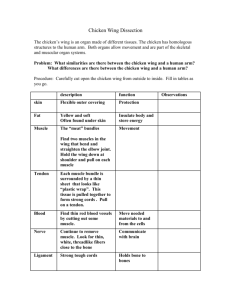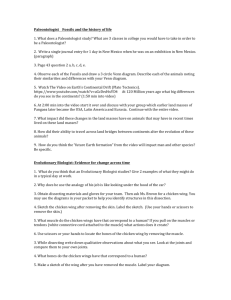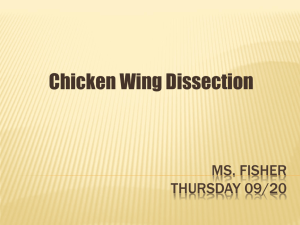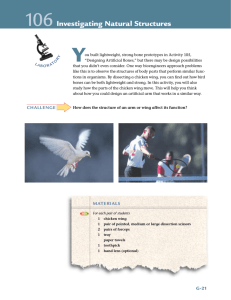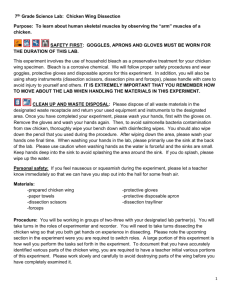Lab: Investigation of a Chicken Wing Jobs
advertisement
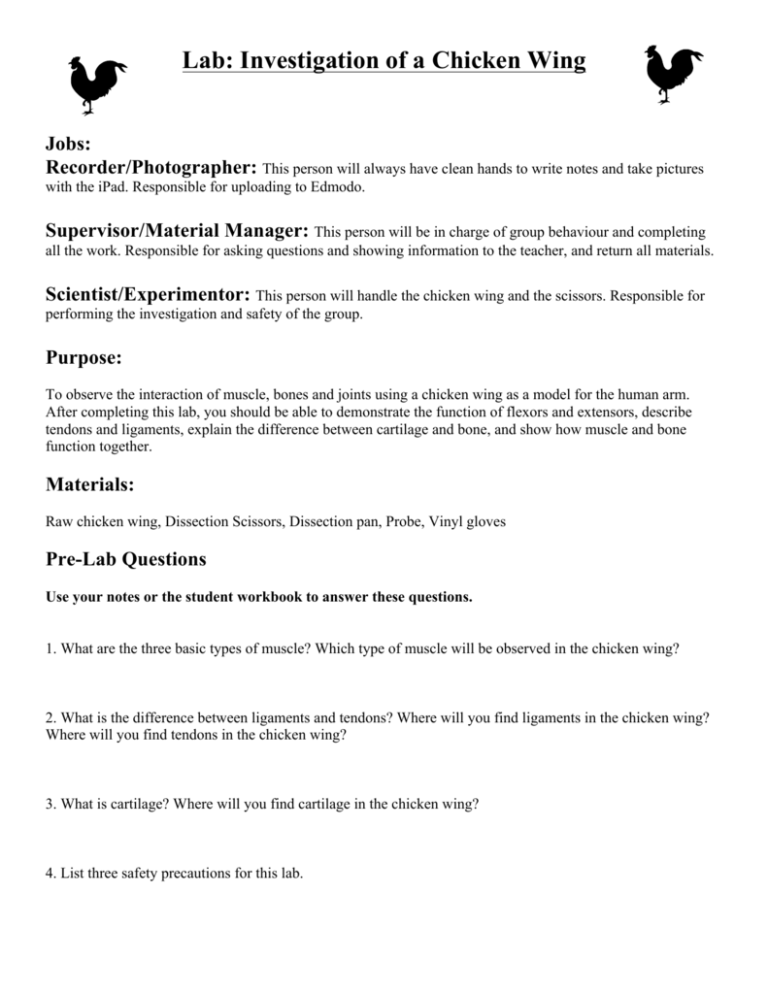
Lab: Investigation of a Chicken Wing Jobs: Recorder/Photographer: This person will always have clean hands to write notes and take pictures with the iPad. Responsible for uploading to Edmodo. Supervisor/Material Manager: This person will be in charge of group behaviour and completing all the work. Responsible for asking questions and showing information to the teacher, and return all materials. Scientist/Experimentor: This person will handle the chicken wing and the scissors. Responsible for performing the investigation and safety of the group. Purpose: To observe the interaction of muscle, bones and joints using a chicken wing as a model for the human arm. After completing this lab, you should be able to demonstrate the function of flexors and extensors, describe tendons and ligaments, explain the difference between cartilage and bone, and show how muscle and bone function together. Materials: Raw chicken wing, Dissection Scissors, Dissection pan, Probe, Vinyl gloves Pre-Lab Questions Use your notes or the student workbook to answer these questions. 1. What are the three basic types of muscle? Which type of muscle will be observed in the chicken wing? 2. What is the difference between ligaments and tendons? Where will you find ligaments in the chicken wing? Where will you find tendons in the chicken wing? 3. What is cartilage? Where will you find cartilage in the chicken wing? 4. List three safety precautions for this lab. RECORDING INFORMATION DURING THE INVESTIGATION. Choose one person who will be the recorder/photographer for the group. This person will not touch the chicken or any tools, in order to have clean hands to write notes and take pictures. The recorder will answer the investigation questions during the lab. Please take pictures and post the completed investigation pages on Edmodo. Be sure to write the names of all group members. PICTURES: Take the following pictures during the investigation: 1. 2. 3. 4. Chicken wing, before it is uncut. Chicken wing with skin removed. Chicken wing with muscles and tendons removed Cut bone showing inner bone marrow (extra credit/if you have time) Email the pictures to all group members. Or, share them with group members in another way (Edmodo, etc.) Part A – Remove Skin 1. Put on disposable gloves and goggles. CAUTION: Even though the chicken wings have been treated with bleach, uncooked chicken can still carry bacteria. Rinse your chicken wing and dry it well with a paper towel. Place the chicken wing on the dissecting tray. 2. Examine your chicken wing. Carefully extend the wing (stretch it out) to find out how many major parts it has. Identify the upper arm elbow, lower arm, and hand (wing tip). 3. Using dissecting scissors, carefully remove as much skin as you can without damaging any underlying structures. Use caution when handling sharp instruments. CAUTION: Cut in a direction away from your hands and body. Part B - Muscles 1. Examine the muscles, which are the bundles of soft, pink tissue around the bones. QUESTION: Using your probe to separate them, how many individual muscles can you identify in the chicken wing? 2. Find the tendons, which are shiny white connective tissues at the ends of the muscle. Show them to Ms. Abellan. 3. Find the two groups of muscles in the upper arm. Hold the arm down at the shoulder, and alternately pull or squeeze on each muscle group. Observe what happens. Now hold the arm at the elbow, and alternately pull or squeeze on each muscle group. Observe what happens. Determine which muscle flexes or bends the arm up, and which muscle extends or straightens the arm. QUESTION: Describe how these muscles work together to produce movement in the wing. (Hint: Can they both contract at the same time?) SKETCH: In the space below, sketch (draw) the wing muscles and tendons. Part C - The Bones and Joints Remove all the muscle from the upper limb, forelimb and wing tip by gathering an entire bundle of muscle and cutting the tendons at the origin (proximal end of the muscle) and the insertion (distal end of the muscle). Cut as close as possible to the bone. Repeat this procedure until you are only left with the skeleton of the wing. (Figure 3) 1. Examine the skeleton and locate the joints that hold the bones together. QUESTION: How many joints do you find on the chicken wing? QUESTION: What type of joint is found in the elbow? How can you tell? 2. Locate the ligaments, which are whitish ribbon-shaped connective tissue that connects bone to bone. 3. Bend and straighten the joint and observe how the bones fit together. The shiny white covering of the joint surfaces is made of cartilage. Show the cartilage and ligaments to Ms. Abellan QUESTION: Why is the cartilage important in the joint area? EXTRA CREDIT / 1. Ask Ms. Abellan to cut a bone in half. Observe the marrow inside the bone. QUESTION: Is bone marrow present? Describe the interior and texture of this substance. How does it differ from the outer bone surface? 2. Separate each individual bone from one another. QUESTION: How many bones are found in one chicken wing? QUESTION: Are there any bones / bone markings on the chicken wing that are similar to our own? Explain. DOWITH YOUR GROUP: ANSWER OBSERVATIONS AND DISCUSSION: Tissue Description (color, texture, etc.) Function 1. Skin 2. Muscle 3. Ligament 4. Tendon 5. Cartilage 6. Bone Marrow ANALYSIS: 1. Do you think this wing is from the left side or the right side of the chicken’s body? Explain your answer. 2. What type of tissue actually moves the chicken wing? 3. What type of joints can be found in the chicken wing? Be as specific as possible and you may include the joint that attaches the chicken wing to the body of the chicken. 4. List two of the most interesting observations you made about the chicken wing, its parts or its function. Conclusion: 1. When eating chicken wings, what tissue is often consumed as “meat”? 2. Describe the various similarities and differences between the chicken wing and the human arm. 3. Based on your observations, explain the roles of bones, muscles, ligaments, tendons, joints, and cartilage in the movement of the chicken wing. 4. Are there any other organisms that would provide a better model of a human joint/limb than a chicken wing? Explain/describe. 5. PICTURES – your group recorder should have emailed you pictures taken during the investigation. Use the different pictures and an annotation program to label the following. • Upper arm, lower arm, shoulder, wing tip • Bicep muscle, tricep muscle, tendons • Bone, joint, ligament, cartilage • Bone marrow (extra credit / if you have time) LABELED PICTURES TURN THEM IN ON EDMODO.
